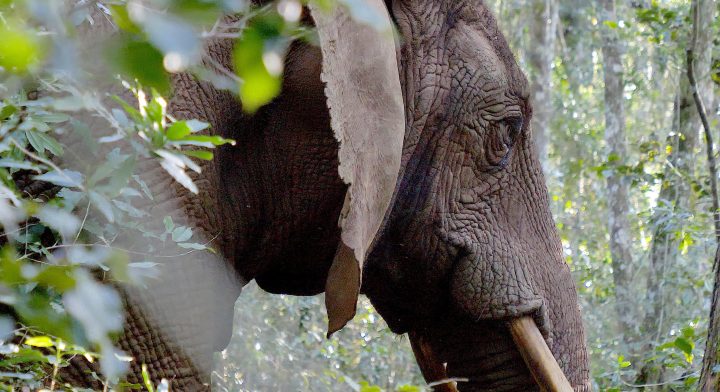SEARCHING FOR STRANGEFOOT
Filmmaker captures breathtaking images of Knysna forest’s elusive elephant cow

After weeks of tracking, living on peanut butter and jam sandwiches, a filmmaker has captured breathtaking pictures of Knysna forest’s lone and elusive surviving elephant cow.
Rangers call her Oupoot, the Matriarch, or Strangefoot. For most people, she has always been a ghost or a rumour, maybe a grainy image on surveillance footage taken in the forest.
It took filmmaker Ryan Davy months to find her and, when he did, she took his breath away.
“Ever since I was a boy, I have been interested in nature and adventure; I have always been intrigued by animal behaviour,” he said.
“I have worked as a wildlife filmmaker for many decades. Adventure has always been a calling, specifically the kind that goes with environmental or humanitarian issues that I feel I can somehow contribute towards by finding a solution.
“As a boy, I would vanish into the mountains with my horse in search of a way I could somehow help the planet. This allowed me to find myself, and become skilled at being isolated and pushing myself beyond a conventional life. Since then, I have always been on the move in search of purpose and fulfilment.
“I have been working on a social media series called Mysterious Creatures and my first species of interest was elephants.”
Davy said that while he was doing his research, he heard of the lone elephant living in the Knysna forest.
“It intrigued me to think that humans knew of a solitary creature that roamed around the forest, but no one really knew enough to say for sure that there was only one, what gender it was and whether or not it actually existed.”
And so a new mission began for Davy.
The search
“I had two incentives to find the Knysna elephant. One is that, if she was still alive, I wanted to campaign that the forest is in need of a herd of elephants. As many may know, an elephant’s primary role in the ecosystem is to clear the thick brush to open the canopy so that light can enter and allow new life to develop. If this element is missing, the ecosystem suffocates itself — that is exactly what is happening in the Knysna forest.
“The second incentive was to get this lonesome [elephant] some company. It didn’t feel right that she was all alone in that vast silent forest. When filming elephants in various countries, I came to realise how socially intelligent they really are and how they depend on each other for survival.
“The solitary female elephant in Knysna does not have that luxury, she relies on herself, which seems cruel and unethical. I wanted to see for myself how she was coping, and based on what I saw, I don’t believe it is natural, so I have embarked on a mission to make sure we get her a family.
“There were rumours that she was not alone, that she was roaming with a small group, but this is not true. There were rumours that she was damaging farm implements, which showed that there was some frustration, and one farmer even told me how he watched security camera footage of her getting affectionate with a tractor, which brought tears to his eyes to know how lonely she must have been. Elephants usually only break things when they are upset or in musth or frustrated.
“It took me 12 weeks in total to find her. I walked 15 to 20 kilometres a day, from sunrise to sunset, and of course during full moon periods, which can sometimes be extremely haunting. I would often track in the rain to find a clean footprint that could give me a good indication of the direction she was taking and the size of her territory.
“Every time I returned to track her, it was in a different season. I wanted to know her movements based on weather and temperature. I would search in November and January, then March, then finally in June. Each time I visited, I stayed for three weeks; this is all the free time I had and my savings only allowed that much time,” Davy said.
Read more in Daily Maverick: Pioneering conflict-avoidance study asks elephants what works for them
Describing the moment when he finally tracked her down, Davy said it was “pure adrenaline”.
“Not from fear of what she would do, but simply because of the amount of time and hard work it had taken to understand her. Many hundreds of kilometres walked, many nights in a sleeping bag on the forest bed listening to every break of a branch, waiting for a clue.
“I would prepare premade peanut butter and jam sandwiches as my fuel since I couldn’t cook or eat anything that would create a crunch in my mouth as it would mask specific sounds I was waiting to hear in the forest.
“From all the information I had gathered to get inside her head, to a certain degree, I was determined to get to see her. When the time came, it was very emotional and rewarding to know that my experience had not failed me; she was exactly where I had hoped she would be.
“There are 50,000 hectares of forest that both she and I had been wandering around in, and finally our paths crossed. She could tell there was another living being nearby, but she didn’t really make much effort to look — perhaps she already knew it was me and realised that I was no threat to her or her habitat.”
Davy said the elephant only showed herself for a brief moment before she “melted” into the forest like a ghost.
“It was one of the most beautiful moments I have ever experienced in all my days as a living, breathing, feeling being in this human form. She was magnificent.
“My brief encounter with this solitary creature left me with a bittersweet flood of emotions. I was broken at the idea that I was leaving her alone in that dense vegetation like a needle in a haystack. I allowed her to slip away as I didn’t want her to panic at the sight of a human and then flee into the thickets with the possibility of hurting herself.”
The case for a herd
Davy said he is more convinced than ever that the lone Knysna elephant needs a herd.
“Of course, if and when we do introduce a herd of elephants into the Knysna forest, then there will be measures to take that will ensure safety for hikers and for farmers on the boundaries of the forests, but these are measures that are fairly easy to manage.
“There are many places on Earth where humans roam in the same vicinity where elephants browse. This is not an anomaly. We can co-exist; we have done it for centuries. Of course, there is a disciplined process involved in the introduction of any species to a new area. It’s not something that can be rushed.
“The Knysna elephant remains alone in the forest, but hopefully for not too much longer. There are a group of concerned environmentalists, including myself, who are working hard to convince the national parks board that they need to stop procrastinating and get their act together.”
Read more in Daily Maverick: Battle lines drawn over the future of elephants
Davy said he believed elephants can play a crucial role in restoring the ecosystem in the Knysna forest.
“In all the time I was inside that forest, I saw only a handful of bushbuck, an overabundance of bush pigs, only one leopard and, of course, an overpopulation of baboons. If the forest had to be opened up, it would allow light in so as to improve the undergrowth, and that in turn will introduce more grazers, which in turn will encourage more predator activity, and so on, creating a much better-balanced ecosystem.
“Many may know of the positive influence the reintroduction of wolves did for Yellowstone National Park [in the US], and how it transformed the land into something more magnificent than it has ever been, simply by a strategic placement of a necessary species. The same applies here.
“There is also an excessive overgrowth of invasive species, which fortunately the Knysna elephant seems to favour, so if more elephants were introduced, it would certainly help in eradicating the invasive flora suffocating our natural heritage, which in turn will benefit us.
“It’s a win-win for everyone, and the circle of life can once again thrive in this beautiful Garden of Eden,” he said.

A close-up of the suspected 50-year-old female elephant that is roaming the Knysna forest. (Photo: Ryan Davy)
‘Unfortunately, he didn’t engage with SANParks’
South African National Parks (SANParks) confirmed that Davy’s pictures are of the Knysna elephant, but said they prefer that she be tracked by non-invasive methods.
Ray Thakhuli from SANParks said they estimate the elephant cow to be about 50 years old.
“In 1994, three elephants were introduced [to the Knysna forest] from the Kruger National Park. After meeting up with a native female elephant and remaining with her for only a short while, one of the introduced elephants died of stress-related pneumonia. The two surviving introduced elephants started spending most of their time on neighbouring farms, where they caused considerable damage. Forestry guards resorted to putting out bales of hay to try to lure them off these farmlands; however, unsuccessfully.
“The introduced elephants endured yet another translocation when, in 1999, they were relocated to a private game reserve. The introduction of elephants from elsewhere into this complex landscape is therefore not simple, and the possibilities in its legal and socio-ecological contexts are currently being discussed by the relevant authorities and parties who will ultimately be responsible for the management of introduced elephants,” Thakhuli said.
“We have seen the footage that Mr Davy took of the Knysna elephant, and it is the same female that SANParks’ remote cameras are capturing on a regular basis. It is unfortunate that Mr Davy did not engage SANParks before he set off on foot to track the Knysna elephant in our managed areas.
“Due to her highly evasive nature and the development of new camera-trapping technology, which makes continuous, non-intrusive monitoring possible, SANParks has stopped intrusive-tracking approaches and leaves the elephant undisturbed whilst receiving good-quality footage of the elephant. We are, however, open to discussions with Mr Davy if he so wishes.” DM
To read all about Daily Maverick’s recent The Gathering: Earth Edition, click here.


















Davy: “12 weeks. 20km a day. No crunchy foods. Sleeping on the forest floor. At last. Evidence. She exists”
SanParks: “Hold my beer…”
My thoughts exactly! Sometimes people are so concerned about their own adventure they fail to learn from others.
Ons wat met Dalene Matthee groot geword het, resoneer en sê, dankie!
It is unfortunate that Ryan Davy did not feel he could communicate with San Parks. I am sure though that he thought he should. My guess is that if he had, we would not have had this important information due to him not being allowed to do what he did.
Sad to say this.
From a elephant perspective, it is very sad that the ‘last Elephant’ of the South is not able to pass on knowledge and genes, in a time when literally millions of rands are spent on ‘conserving’ elephant in areas where they are plentiful …. This is a very controversial subject, I know, which is badly affected by conservation/preservation woke-ism. Please support this man. Well done Ryan.
From what I understand elephants use a lot of inherited knowledge of their habitat that enables them to survive. Being such a unique habitat, if the female is unable to pass on her knowledge, it may be impossible to reintroduce elephants to the area without the previously experienced problems.
Too harsh on SanParks. The story brings nothing new – the elephant has been there all along…
Post script to my comment.
I am a minor shareholder in a ‘conservancy’ of close to 30,000 hectares that has just over 150 elephant in it. It is fully fenced and has adjoining farms. Problems are minimal.
Well done, Mr Davy. What an amazing experience. Thank you for sharing this with us.
The problem is diet. The forest elephants eat different foods to veld elephants.
Relocating bushveld elephants from the Kruger to a forest thicket habitat was doomed to fail. Forest elephants from Congo or CAR would be far more likely to be successful.
So very sad that she leads such a lonely life 🙁
This makes sense
They’d be a different species to her though, so maybe breeding wouldn’t happen. Loxodonta cyclotis (Central & Western forest ellies) vs Loxodonta Africana.
Congo elephants are now classed as a separate species to Bushveld ellies. The knysna elephants used to exist in large numbers and would drift in and out of the forests when good feeding was available outside. Same with the enormous herds of Buffalo that are no more. The tuskless African Bush elephants found in Addo are the closest genetic relatives to oupoot, and culturally they have the best chance of being able to join with her and to learn the ways of the forest. Elephants rely upon deep inter-generational wisdom. Right now, that one elephant holds the secrets of tens of 1000s of years.
I am crying
Well if she’s 50 she could still breed for a decade or two. SanParks seems strangely uninterested about the whole thing. Affirmative management I suppose..
Is this a real life project to create an online adventure for the benefit of social media, rather than for the benefit of the elephant?
The forest needs a herd to keep open spaces as he explained. Sound ecology for the forest, not a news item for people.
SANParks. The same Muppets who are presiding over the extinction of our rhinos, thinks they know better. There is a large population of elephants in Addo, vastly better suited for reintroduction than Kruger ellie. And introduced animals need to be done slowly. Dumping three kruger elephants into a forest was never going to work, moenie kak praat nie SANParks, laat die mense doen wat jy kan nie.